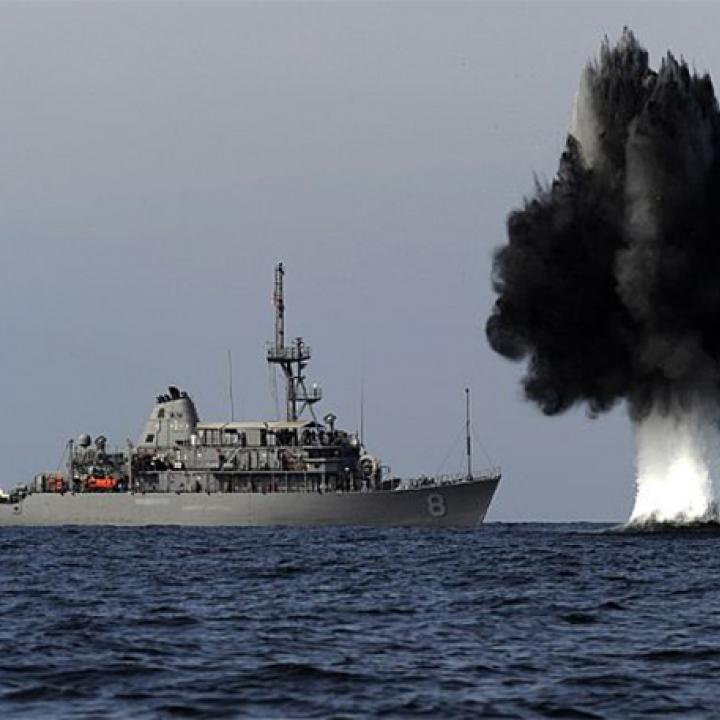
- Policy Analysis
- PolicyWatch 3302
Iran Gets Aggressive in the Northern Gulf Following U.S. Military Exercises

Recent joint drills by the U.S. Navy, Army, and Air Force have essentially challenged Tehran to a game of contested deterrence, spurring its forces to respond with swarm maneuvers and a vessel seizure.
On April 15, U.S. Naval Forces Central Command reported a series of “dangerous and unprofessional” maneuvers by Islamic Revolutionary Guard Corps Navy (IRGCN) speedboats in the northern waters of the Persian Gulf. Based on photo and video evidence published by NAVCENT, the encounter was unprecedented in several respects: it involved a relatively large number of armed boats (up to eleven in one case) aggressively encircling and swarming U.S. naval vessels at unusually close ranges.
The confrontation came one day after an incident near the Strait of Hormuz, where the Hong Kong-flagged, Chinese-operated tanker SC Taipei was halted in international waters by Iranian armed boats, either maritime police forces or IRGCN. The vessel was then taken into Iranian waters off Kuh-e Mobarak, where a maritime police outpost is located. The International Maritime Security Construct, currently led by the British Royal Navy, patrols those waters but reportedly chose not to intervene upon learning of the incident. Hours later, the tanker was freed to continue to its destination in Saudi Arabia—presumably after the Iranians realized it was a Chinese vessel.
These aggressive moves should have been anticipated. According to intelligence reports, Iran’s naval assets in the Gulf have been abnormally active since early January, after the U.S. targeted killing of IRGC-Qods Force commander Qasem Soleimani. Tensions escalated further following a deadly March 11 militia attack in Iraq, in which pro-Iranian forces killed American and British service members. That same month, almost all branches of the U.S. armed forces began conducting joint defensive exercises in the Gulf’s central and northern waters. Judging by Iran’s response, the nature and scope of these drills have set off alarm bells among the IRGCN leadership.
TIT FOR TACTIC
The U.S. exercises involved tactics based on both new and proven methods of sea-basing and forward-deploying Army helicopters. During U.S.-Iranian confrontations in 1987-88, light-attack Army helicopters operated out of two converted barges off the Saudi coast, using nighttime ambushes to take out numerous Iranian speedboats suspected of minelaying.
Today, such tactics have been refined to counter sudden Iranian swarm maneuvers using assets with a more kinetic footprint, such as the Air Force’s AC-130W Stinger II gunships or the Army’s AH-64E Apache Guardian attack helicopters. Apaches now operate out of the large USS Lewis B. Puller, the Navy’s first permanent “expeditionary sea base.” This mothership, which replaced the USS Ponce in the northern Gulf in August 2017, can simultaneously accommodate up to four large CH-53E minesweeping helicopters or Apache and Black Hawk helicopters.
Over the past few years, the United States has tested a range of weapons and methods against Iran’s swarming boats and drones. These include high-power microwave and laser systems (including the LaWS deployed on the Ponce), modified antitank missiles, guided 70 millimeter rockets, and defensive swarm drone boats. Moreover, besides its usual assortment of guns, the AC-130W is armed with GBU-39 and GBU-53 small-diameter glide bombs, with the latter capable of precisely engaging moving targets at a range of 72 kilometers (or 110 kilometers against stationary targets). The Navy has also previously exercised with Air Force A-10 Thunderbolt attack aircraft, another effective platform against maneuvering speedboats.
For its part, Puller is ideal for expeditionary operations in areas of the Gulf where shore bases are not immediately available, whether due to logistical or political reasons. With a mix of 100 military and 44 civilian crew members, it provides a unique and flexible platform to U.S. forces in the region. The vessel is also an obvious choice for supporting special operations in the highly sensitive waters around the IRGCN base at Farsi Island. That facility overlooks shipping routes to and from Kuwait, where most of the U.S. military’s logistical support network is currently based.
REVIVING AND UPDATING OLD CAPABILITIES
According to NAVCENT’s April 15 statement, U.S. forces in the Gulf have increasingly relied on combined action teams “to detect, track, engage, and defeat surface threats in order to control water space.” These teams typically include Navy warships and Cyclone-class coastal patrol craft armed with short-range Griffin missiles, though both vessels mainly serve as target locators for airborne firepower. Most recently, these teams have practiced “holding enemies at high risk at extended ranges,” which entails using patrol craft to spot fast-moving boats that pose a threat, then having Apaches pepper them with 30 millimeter chain guns, guided rockets, and Hellfire missiles at a range of up to 11 kilometers.
Such cooperation has not been seen in the area since Operation Earnest Will in 1988, when the barge-based Army helicopters mentioned earlier were involved in several engagements with IRGCN forces, causing a number of casualties. More than three decades later, IRGCN officials still promise to avenge those episodes in occasional public remarks.
ANTICIPATING IRANIAN AGGRESSION
The IRGCN is well aware of the new, more flexible U.S. capabilities currently being demonstrated in the Gulf, noting the increased tempo of operations from the Puller and the specific intention to counter Iranian swarm tactics. Accordingly, the Guards have increased their aggressiveness in the vicinity, as they usually do when an adversary demonstrates such flexibility.
In an April 19 statement, the IRGCN claimed two separate incidents of “unsafe and irresponsible” U.S. naval interference: on April 6 and 7, almost 200 kilometers apart in two different IRGCN districts. Curiously, both incidents involved a single, slow-moving IRGC support vessel.
The statement also alleged that the April 15 swarming incident described earlier was initiated by U.S. forces, who interfered in a previously declared IRGCN live-fire exercise. Video evidence released by the U.S. Navy indicates otherwise, however—the Iranian boats repeatedly employed tight-circling and harassing tactics very similar to those used during a chain of incidents in 2016, when U.S. destroyers and patrol vessels were openly threatened near the Strait of Hormuz.
Indeed, U.S. forces can expect continual incidents so long as their joint exercises are visibly tailored to counter IRGCN speedboats. And the more uncomfortable Iranian authorities grow about such activity, the more candid and aggressive their responses will become. The U.S. military should therefore be prepared for higher risk of quick escalation aimed at contesting its localized deterrence.
The concept of “contested deterrence” was coined by CENTCOM commander Gen. Kenneth McKenzie during a congressional hearing on March 11. The term stems from Iran’s longstanding rejection of any foreign security presence in the Gulf. In the IRGC’s view, the presence of Western military forces constitutes interference in regional affairs and defense—even though Iranian maritime law includes no provision for security cooperation with its regional neighbors.
Likewise, Iran does not formally recognize freedom of navigation in the Gulf or the Strait of Hormuz. In its view, the latter waterway is not an international strait, so “transit passage” through it is not an inalienable right. In practice, however, Iranian forces usually avoid direct maritime confrontations aimed at asserting these claims—except when they want to show serious dissatisfaction with a given development.
CONCLUSION
Tehran has clearly noticed the U.S. military’s increased preparedness to defend American interests and freedom of navigation in the region, from novel joint exercises in Gulf waters to the now common presence of at least one aircraft carrier group in the nearby Arabian Sea. The recent deployment of IRGC artillery rockets and antishipping missiles along Iranian shores overlooking the Strait of Hormuz suggests that the Guards are signaling they can close the waterway if necessary.
This kind of behavior further indicates that Iran will contest the U.S. Navy’s willingness to stand its ground even further in the coming months, as part of an ongoing game of deterrence. Although IRGCN forces may limit this activity to harassment operations in the near term, they will likely resort to more assertive means over time.
Farzin Nadimi is an associate fellow with The Washington Institute, specializing in the security and defense affairs of Iran and the Gulf region.

